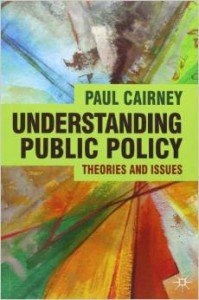Note: today is 20 July 2023 and I just found this post in my ‘drafts’ folder. It was written 22 August 2014! I’ve read it through and it seems that the only thing I didn’t get round to doing was putting on a reference list and sorting out some formatting. Or, maybe I had some other points I wanted to make – perhaps more detail on policy process and/or health policy because I don’t touch on all the books who I introduce at the beginning. It’s interesting that at that time I was thinking about doing my PhD in ‘field’ of health in all policies, but now that in the past…..
A few months ago I wrote my Policy Safari post which outlined the reasons for my interest in policy. The interest has got stronger since then – the more I think about it the more I would like my PhD research to be in the ‘field’ of healthy public policy/health in all policies. I’ll write a post soon outlining the background to and use of these ‘ideas’, but in order to start to tease apart what they are and how you seek to achieve these ideals, I think you need to start with two contested concepts that underpin them – what is (public) policy? (plus what are the theories about how it is ‘done’?) and what is health? (plus what are the theories about how it is ‘made’/’damaged’?) As these two concepts are understood in such a multiplicity of ways in isolation then putting them together in phrases such as ‘healthy public policy’ and ‘health in all policies’ is kind of a recipe for complete confusion.
So I want to take a step back a little and concentrate on my Policy Safari first of all. I’ve found myself a few guidebooks to help me on this tour. I’ve lined up the main ones below.
–
and once you open them the first question that seems to be discussed is ‘what is policy, anyway?’.
It turns out that, even though I use this word 100s of times a day in my working life, that it is a very slippery thing.
The first time I formally studied this notion of ‘policy’ was during the Open Uni module TU870 Capacities for managing development so the discussions of policy slanted towards international development. The course materials included as an excerpt the introductory chapter from a 1992 book called Development Policy and Public Action. In the chapter Mackintosh defines policy as:
‘Policies’ are purposive actions undertaken by the state (government and their employees), or by other institutions (such as voluntary organisations), with an avowedly public purpose. That is, they are actions conceived as (or defended as) serving some wider public objective such as social and economic development, and not (or not solely) for individual private gain. Hence, not all actions by public institutions are ‘policy’. Institutions and organisations make policy in so far as they act or claim to act for the public good
Mackintosh (1992, p.2)
Bearing in mind that I studied this module as the last one in my MBA when my head was crammed full of the word ‘Strategy’ – for me this explanation was helpful in a number of ways. Firstly, I could create a distinction between ‘strategy’ which is about the objectives of an organisation (in private sector = create shareholder value) to ‘policy’ which is about serving a public objective (in private sector an example would be there equal opportunities employment policy). That distinction does get a bit blurry when applied to public sector organisations where the objectives of the organisation are about serving a public objective but all the same it was a useful thought. Secondly, I was interested in the idea of ‘purposive actions’ – i.e. actual actions, not a plan or a decision or an intended action – again drawing from the rest of my MBA studies this resonated with Mintzberg’s discussions of ‘realised strategy’ – which will be a combination of what was intended and what emerged along the way. Thirdly, I liked the idea that a range of institutions could ‘do’ policy – it didn’t have to be ‘done’ by government to be an action seen as serving a public purpose. And finally, I like the slightly political ‘hint’ that the actions could be ‘defended’ as serving a public purpose – someone can ‘dress up’ something that is really for private gain in policy clothes.
Mackintosh’s introductory chapter also introduced the idea of policy as process – the idea that policy emerges from a social process – one that consists of interactions of ideas and agencies. This was a big leap from the more conventional, rationalistic view of ‘policy as prescription’ – the idea that it was only the ‘rational’ plans and use of formal levers (e.g. legislation, regulation) by government.
Now to my other books, Cairney (2012) writes of ‘public policy’ which is the ‘variant’ of policy that is focussed on what government is doing – or not doing. His second chapter is titled ‘What is public policy?’ but annoyingly for me he doesn’t have a nice neat encapsulated ‘definition’ that I can quote because (quite rightly I suppose) he aims to highlight the competing perspectives on the contested thing that is public policy. The chapter draws out key points from literature to show just how many things ‘policy’ can refer to
policy can refer to an aim, a decision or an outcome; it may refer to issues that policy makers do not address; and, it is made and influenced by many actors who may or may not have formal authority
Cairney (2012, p.22)
as a label for a field of activity […]; an expression of intent […]; specific proposals […]; decisions of government and the formal authorisation of decisions […]; a programme, or package of legislation, staffing and funding […]; intermediate and ultimate outputs […]; outcomes or what is actually achieved […]; and a process, not an event, or a series of decisions, not a single decision
Cairney (2012, p23/24)
It is no wonder that on a day to day basis we confuse each other by using the word ‘policy’ without any additional clarification. Cairney’s concern is with policy analysis – how do we understand or formally research this nebulous ‘thing’. The complexity and the contested nature of policy means it is helpful to step forward with particular ‘lenses’ – each suitable for seeing particular things but carrying the risk they will ignore others. Options include looking at the type of policy; the instruments used; the narratives and framings in policy; and applying theories and models – the best known of which is the policy ‘cycle’ (which although firmly embedded in everyone’s psyche as the way it should be is the subject of much controversy itself).
Now to Hill (2013) who also takes the stance that defining policy is not just difficult but hints at that activity being inappropriate:
a distinction can be drawn between approaches to this concept – often from a prescriptive perspective – that endeavour to use a very precise meaning and the stance taken in this book that political and ideological contests make that activity difficult and/or contentious
Hill (2013, p.3)
Consistent with the title of Hill’s book his interest is in the policy process – something that is multi-layered and – yes, here it is that word again – complex. On page 15, Hill includes a box with citations from four different authors about what policy ‘is’ – all these definitions highlight is that it is difficult to treat it as something concrete. The implication for someone ‘researching’ policy is that different actors will be using it in different ways – something worth exploring in its own right. The key issue arising is is that policy is dynamic and evolving – ‘a’ policy on ‘something’ is difficult to pin down – in a way you are taking a snapshot in time. Hill’s discussions remind me of Vickers conceptualisation of “everyday life as a flux of intertwined ideas and actions unrolling through time” (Checkland 2011, p.508) – I find it helpful to think of policy in these terms – to once again draw on Vickers to use this metaphor as an ‘appreciative setting’ for looking at policy – something that has a history and a future, that unfolds, involves actions and involves ideas. For me, here policy becomes an intertwined element of ‘social change’ – some policy proposals may not be culturally feasible at one point in time but social change can make them feasible – take for example the UK bans on smoking in public places.
The book edited by Budd, Charlesworth and Paton (2006) on Making policy happen is more concerned with the activity of ‘policy work’ – what does it mean to make or implement policy [even make and implement contain within them assumptions of what policy is – I’m getting reticent to use any everyday words now!]. As someone who does practice in the domain of policy work [or at least I think I do!] I’ve always loved the description that the editors put in the introduction to the book:
policy work is a broad concept and its central characteristic is that it is a higher-order activity. Its impacts are indirect: it produces frameworks (of direction, authorisation, restriction, principles, resources, etc) within which a wide range of governmental and non-governmental actors must operate. As such, policy work is abstract and immaterial. Its primary medium is the document – it consumes, generates and produces papers of all sorts. It is about the facts concerning what are taken to be societal issues (affecting whom, why, how often, where, at what costs?…but also, always: says who and on what basis?). But equally it is about the values (the mix of aspirations, principles and commitments that matter for particular communities) from which those societal concerns spring. So policy work involves politics: it is about conflict management and the integration of divergent societal interests as much as technocratic problem solving; and policy formulations have to be expressive as well as instrumental. Here too, policymaking is often an arena for battles of ideas; it is as much about narratives and making sense of the past (why is this happening to us?) as it is about improving the future.
Budd, Charlesworth and Paton (2006, p.1)
Seen like that it feels like a very exhausting thing to do. But whilst the day to day activity is often fast and furious, the impacts are often slower to come about – it’s not the sort of thing that you can ‘performance manage’ in terms of results or outcomes very easily – long-time frames and attribution problems create havoc with the assumptions embedded within many performance management frameworks.
References
Cairney, P. (2012), Understanding public policy: theories and issues, Basingstoke, Palgrave Macmillan
Checkland, P. (2011), Autobiographical retrospectives: Learning your way to “action to improve” – the development of soft systems thinking and soft systems methodology. International Journal of General Systems, 40(5), pp.487–512.
Hill, M. (2013) The public policy process, sixth edition, Harlow, Pearson Education Ltd
Mackintosh, M. (1992) ‘Introduction’ in Wuyts, M., Mackintosh, M., Hewitt, T. (Editors) Development Policy and Public Action, Oxford, Oxford University Press/Open University





